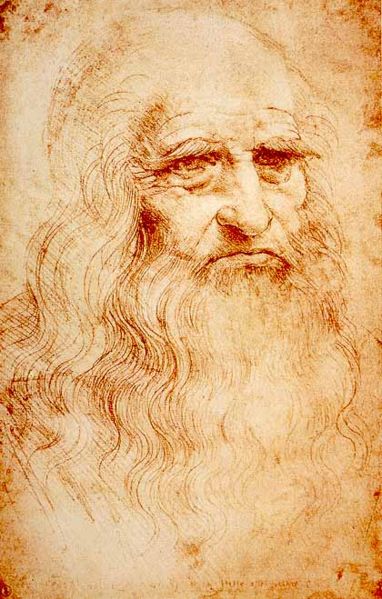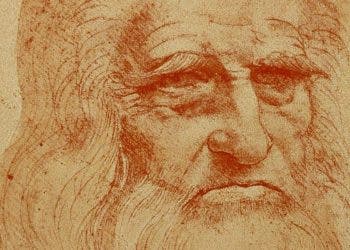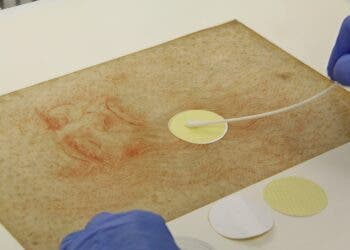
For more than five centuries, Leonardo da Vinci’s Vitruvian Man has invited admiration but also bafflement. With its harmonious symmetry of limbs outstretched in both a square and a circle, the drawing seems to promise a key to nature’s secrets. But one question has lingered in scholarly circles: how exactly did Leonardo construct it?
A new study may finally have an answer. According to a London-based dentist named Rory Mac Sweeney, the key to understanding the Vitruvian Man, it turns out, was hiding between the figure’s legs. According to Sweeney, the figure’s legs form an equilateral triangle, matching another equilateral triangle that draws the ideal human jaw.
The Enduring Genius of the Vitruvian Man
Leonardo da Vinci’s Vitruvian Man — drawn around 1490 — has become one of the most reproduced, revered, and reinterpreted images in history. More than a sketch, it’s a thesis about humanity’s place in the cosmos.
At the time, artists and architects were enthralled by the writings of Vitruvius, a Roman engineer who claimed that the ideal human body could be used as a model for perfect buildings. His idea was simple: just as a well-designed temple has harmonious proportions, so too does the human form. But Vitruvius left one crucial question unanswered — how, exactly, could a body be placed inside both a circle and a square?
Leonardo did more than illustrate the idea. He solved it.
Instead of aligning both shapes to the same center, Leonardo offset them. He placed the center of the circle at the man’s navel — his axis of rotation — and the square’s center at his groin. That subtle shift allowed the limbs to stretch into both forms. The result wasn’t just geometrically clever. It felt true.
A Triangle in Plain Sight
In his notes around the drawing (sometimes called the Canon of Proportions or the Proportions of Man), Leonardo wrote something that has long been overlooked: “the space between the legs will be an equilateral triangle.” That small phrase — long dismissed as poetic flourish or compositional guidance — has now been identified as a literal clue.
“I think we’ve all been looking for a complicated answer,” Rory Mac Sweeney, a dentist and independent researcher based in London, told The Independent. “But the key was in Leonardo’s own words. He was pointing to this triangle all along.”
Mac Sweeney’s peer-reviewed study, published in the Journal of Mathematics and the Arts, proposes that the triangle Leonardo described matches a precise anatomical feature discovered nearly 400 years later: Bonwill’s Triangle.

This geometric figure — first identified by dentist William Bonwill in 1864 — is formed by connecting the two points where the lower jaw hinges with the midpoint between the front lower teeth. In most adults, each side of the triangle measures about 10 centimeters.
In modern dentistry, Bonwill’s Triangle is foundational. It’s used to build dentures and understand how the jaw moves efficiently. But Leonardo, it seems, may have foretold its geometry long before X-rays or surgical tools could confirm it.
A Ratio Rooted in Nature

By placing this equilateral triangle between the legs of the figure, Leonardo achieves a specific proportion in the drawing. The side of the square compared to the radius of the circle yields a ratio of roughly 1.64–1.65.
Mac Sweeney points out that this ratio closely mirrors what mathematicians call the “tetrahedral ratio” — 1.633. This is the proportion that arises in the geometry of the simplest three-dimensional shape: the tetrahedron, a pyramid made of four equilateral triangles. It’s also the same ratio found in the most efficient way to stack spheres (think oranges in a supermarket crate) or in the atomic structure of certain metals.
“Leonardo’s systematic construction yields a ratio… matching both published measurements of the original drawing and the tetrahedral ratio of 1.633,” the study notes.
“What’s truly amazing is that this one drawing encapsulates a universal rule of design. It shows that the same ‘blueprint’ nature uses for efficient design is at work in the ideal human body,” Mac Sweeney argues.
Geometry, Biology, and the Human Face
The implications go even further. In the 20th century, dental researchers like George Monson expanded on Bonwill’s work to suggest that the teeth align along a spherical surface, centered near the forehead. When the jaw is modeled in three dimensions, it forms a tetrahedron with Bonwill’s triangle at the base.

Whether in dental geometry, the curve of the human skull, or Leonardo’s drawing, 1.633 seems to be a recurring theme.
Broader anatomical studies seem to confirm this insight. A 2019 study of 100 human skulls found a consistent cranial ratio of 1.64 ± 0.04 — again remarkably close to the tetrahedral constant.
This evidence from art, anatomy, and geometry converges to the idea that Leonardo wasn’t just sketching a handsome man. He was, consciously or not, illustrating a principle of natural efficiency.
“Leonardo knew, or sensed, that our bodies are built with the same mathematical elegance as the universe around us,” said Mac Sweeney.
A New Chapter in an Old Masterwork
Historians have long known that Leonardo dissected cadavers, filling notebooks with observations of muscles, bones, and organs. But this new analysis suggests he may also have grasped structural relationships that modern science only formalized centuries later.
Leonardo’s construction method, Mac Sweeney argues, wasn’t based on symbolic mysticism or golden ratios alone, as previously suggested. Instead, it reflected an empirical approach grounded in geometry and observation.

It’s not the first time the Vitruvian Man has attracted geometric speculation. Previous researchers proposed that Leonardo used polygons like heptagons or octagons. Others assumed he had relied on the golden ratio—1.618—a number famously associated with beauty in art and nature.
But those models never quite fit the drawing’s measurements. They also failed to answer a basic question: why would Leonardo have used those shapes in the first place?
Nature’s Geometry
If the findings hold up under further scrutiny, they may shift the way art historians and scientists interpret the Vitruvian Man. The drawing may no longer be seen simply as a Renaissance icon, but also as a conceptual prototype for biomechanical understanding.
It would not be the first time that nature’s geometry has inspired design. Architect Buckminster Fuller, who developed the concept of “tensegrity” structures — describing structural systems as ‘islands of compression in an ocean of tension’ — also found the tetrahedral ratio at the heart of his work.
In his view, natural forms like dental occlusions and crystals reflect a balance between tension and compression. The same might be said of the human body, as modeled in Leonardo’s pen strokes.
From dental labs to molecular lattices, the same geometric patterns seem to remarkably recur. And now, thanks to a triangle hidden in plain sight, we may finally see that Leonardo had spotted the same pattern too.






